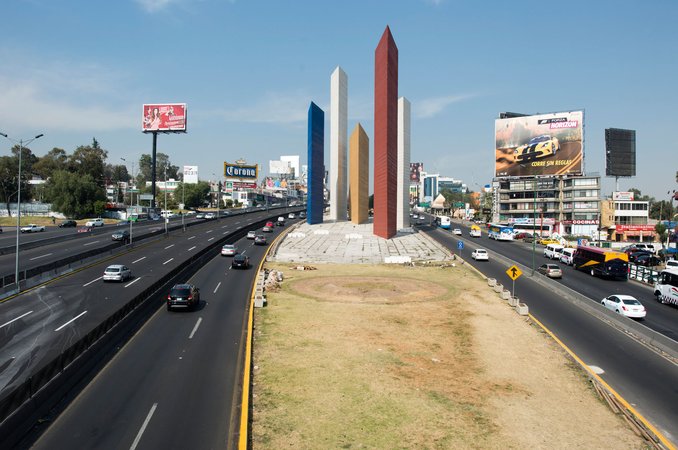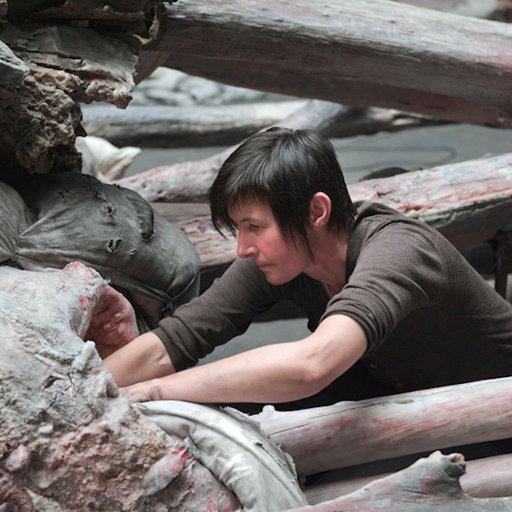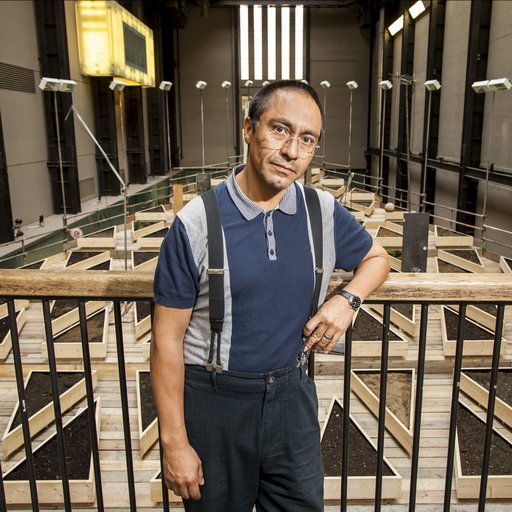Mexico City's trendy new art scene filled with artist-run schools and spaces comes from a long history of support for the arts. Many of its public works make reference to historic sites and events, as with Espacio Escultórico referencing the pyramid of Cuicuilco or the murals of Universidad Nacional Autónoma de México, by the most important Mexican artists of the time, elucidating various eras in Mexico's long history. From Phaidon's Art & Place, we've chosen three of the most awe-inspiring and impressive public works in Mexico City today. Next time you're in town for a studio visit or Material Art Fair, be sure to visit everything reprinted below.
Ciudad Satélite
Mathias Goeritz and Luis Barragán

Cinco Torres, known by the inhabitants of Mexico City as Torres de Satélite, are five concrete towers in triangular prism shapes of different heights (from 31–54 m / 103–176 ft) created by sculptor Mathias Goeritz (1915–90) and architect Luis Barragán (1902–88) as sculptural monuments designed to welcome people to the new district of Ciudad Satélite, situated to the north of Mexico City. The Ciudad Satélite development project had been assigned to renowned architect and urban planner Mario Pani, who invited Barragán and Goeritz to participate by creating a public work of art. The towers are sited on a principal highway in the area and have become a distinctive landmark that can be seen from far away.
Originally conceived as a monument of seven towers in reference to cabbalistic numerology, with the tallest tower being 198 m (650 ft) high, the initial project was scaled down due to budgetary constraints. Goeritz had wanted to paint all the towers the same color with some tonal variations but they finally decided to use markedly different colors: white, yellow, blue, and orange. The colors were changed on several occasions: for the 1968 Olympic Games the towers were all painted orange, in 1989 one of the towers was painted blue and another one red, and finally in 2008 they were changed back to their original colors.
Barragán had been inspired by the medieval towers of San Gimignano, in Tuscany, which he had visited in 1951. At the same time, Cinco Torres also represents several of Goeritz’s aesthetic principles, such as his concept of emotional architecture, in which the spiritual qualities and beauty of buildings are considered to be more significant than their functional values. In Cinco Torres the minimalism and impressive verticality of the towers express the spiritual quality of the monument. The towers became a symbol of a new type of urban monumental sculpture that broke with conventional architectural traditions of the past. The Cinco Torres embody the spirit of modern utopia of 1950s Mexico City.
Polyforum Siqueiros
David Alfaro Siqueiros

The world’s largest mural, The March of Humanity on Earth and Toward the Cosmos by David Alfaro Siqueiros (1896–1974), represents the culmination of what could be described as “the Mexican mural renaissance.” Created between 1960 and 1971, The March of Humanity is complex and, in many ways, is atypical of Mexican muralism. Its various panels are located on the exterior and interior of the Polyforum, a building created specifically for them in the Parque de la Lama, in southern Mexico City. The entire cultural and commercial complex–which also includes the Hotel de México, a major tourist hotel–was commissioned by wealthy Mexican industrialist and modern art patron Manuel Suárez, also known for his conservative politics.
Twelve mural panels jut out from the Polyforum’s exterior, like facets on a diamond. The building’s interior is in the shape of an ellipse, with fresco panels again forming facets on the walls, and decorating the ceiling. Painted in acrylic on asbestos and cement, the murals also incorporate low-relief sculpture. Baroque swirls of color, light and dynamic figures animate the panels, incorporating influences from abstraction and expressionism. The theme is ambitious and universal: human beings’ struggle throughout history for a better society.

In contrast to other works by Siqueiros, here there are no explicit political references, although the murals clearly respond to 1960s Mexican politics, when the government was promoting tourism and international ties. Designed with tourists in mind, the complex still welcomes visitors who arrive daily on buses to tour the site. Viewers can admire the interior murals from a rotating stage inside the Polyforum, while enjoying a recorded light and sound show narrated by Siqueiros himself.
[related-works-module]
Universidad Nacional Autónoma de México
Mathais Goeritz, Helen Escobedo, Manuel Felguérez, Hersúa, Juan O’Gorman, Sebastián, Federico Silva, David Alfaro Siqueiros

Originally founded in 1551, for many centuries the various faculties of the Universidad Nacional Autónoma de México (UNAM) were scattered across the centre of Mexico City. In 1954 they were finally brought together at the University Campus (CU), a single site.
Expansive murals adorn a number of the campus buildings and highlight the university’s role in Mexico’s history.
The murals were created by some of the most important artists of the time, including David Alfaro Siqueiros (1896–1974), whose work can be seen in the Rectoría building (including The People to the University, the University to the People), and Juan O’Gorman (1905–82), who was responsible for the facade of the Central Library.

The outside walls of the monolithic library building present the largest mural in the university complex. O’Gorman’s Historical Representation of Culture entirely covers the walls’ surface with a mosaic in natural stone. Each wall portrays a different phase in Mexico’s history with which O’Gorman associated an emblem. The north wall, dedicated to Pre-Hispanic Mexico, is dominated by an eagle on a prickly pear devouring a snake, symbolizing the foundation of the capital of the Aztec Empire. The south wall, depicting the colonial past, shows the coat of arms of the House of Habsburg, the reigning dynasty at the time of the Conquest. The east wall with the atom represents modern Mexico, after the revolutionary struggles of the workers and peasants. The west wall represents the university itself and displays the institution’s motto: Por mi raza hablará el espíritu (On behalf of my race the spirit will speak).
Beyond the teaching areas lies the Centro Cultural Universitario. Created in the 1970s, its artistic legacy includes the Espacio Escultórico, a public area designed by a collective of six sculptors. This collaboration resulted in a circular, crater-like space made of volcanic lava over which tower sixty-four 4 m (13 ft) tall polyhedral monuments.
[related-works-module]
























